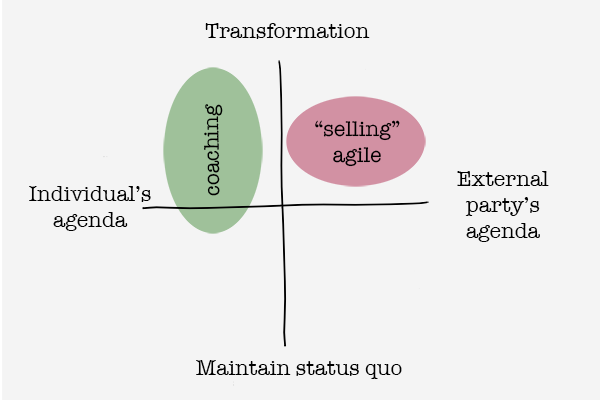Introduction
What is an ‘Agile Coach’? Aren’t those two words contradictory? I removed the ‘Agile’ part when describing what I do a few months ago and a meetup this week raised the same topic. So what’s the problem?
Coach definition
Jenny Rogers, in her book Coaching Skills, says “Coaching starts and finishes with the client’s agenda. This is because coaching is about change … Clients know their lives in a way that the coach never can, so only the client can say what the agenda for change is. The coach’s role is to ask the questions which uncover the client’s agenda and make it explicit, turning this agenda into the goals which the client can work on and safeguarding it as the only agenda for coaching. The coach links the agenda with the client’s core values and beliefs and works with the client to identify and then move past the blocks and fears which are holding them back.”
Agile
A set of values and principles.
The problem
Imagine I’m hired to coach senior members of an organisation. These people run a department with loads of teams made up of hundreds of people. The teams are working in long, waterfall-based cycles which take so long that demands change and often nothing goes out the door. “We’d like you to coach the senior managers on agile so they understand our approach and are bought into it. This will improve ways of working when tech and the rest of the business work together.” In this instance, coach means sell. There is an agenda that someone wants to push onto the senior managers. That is not what coaching means to me.
So do I reject a request like the one above?
Of course not. I am happy to sell the agile values and principles because I believe in them and they can usually help organisations improve. Also, I probably wouldn’t even get a chance to speak to senior managers if they didn’t think I had something to offer; if we went directly to propose some coaching, they probably wouldn’t even respond. But we need to acknowledge that we wear many different hats: sometimes an expert; sometimes a coach; sometimes a sales person; sometimes a trainer; etc. So we should be clear which hat we’re wearing at any time. I find the Brockbank-McGills matrix helpful to identify where I am at any time:

Conclusion
Rarely does our role fit neatly into a specific box. We may spend most of our time performing one or two roles but sometimes we drift in order to achieve a certain goal. That’s fine, but we mustn’t dress it up as something that it isn’t; we should be clear of our intentions and to whose agenda we are working to.
